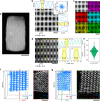DNA origami single crystals with Wulff shapes
- PMID: 34021131
- PMCID: PMC8140131
- DOI: 10.1038/s41467-021-23332-4
DNA origami single crystals with Wulff shapes
Abstract
DNA origami technology has proven to be an excellent tool for precisely manipulating molecules and colloidal elements in a three-dimensional manner. However, fabrication of single crystals with well-defined facets from highly programmable, complex DNA origami units is a great challenge. Here, we report the successful fabrication of DNA origami single crystals with Wulff shapes and high yield. By regulating the symmetries and binding modes of the DNA origami building blocks, the crystalline shapes can be designed and well-controlled. The single crystals are then used to induce precise growth of an ultrathin layer of silica on the edges, resulting in mechanically reinforced silica-DNA hybrid structures that preserve the details of the single crystals without distortion. The silica-infused microcrystals can be directly observed in the dry state, which allows meticulous analysis of the crystal facets and tomographic 3D reconstruction of the single crystals by high-resolution electron microscopy.
Conflict of interest statement
The authors declare no competing interests.
Figures




Similar articles
-
Fabrication of Functional 3D Nanoarchitectures via Atomic Layer Deposition on DNA Origami Crystals.J Am Chem Soc. 2025 Mar 19;147(11):9519-9527. doi: 10.1021/jacs.4c17232. Epub 2025 Mar 6. J Am Chem Soc. 2025. PMID: 40049611 Free PMC article.
-
Programming the morphology of DNA origami crystals by magnesium ion strength.Proc Natl Acad Sci U S A. 2023 Jul 11;120(28):e2302142120. doi: 10.1073/pnas.2302142120. Epub 2023 Jul 3. Proc Natl Acad Sci U S A. 2023. PMID: 37399399 Free PMC article.
-
Full Site-Specific Addressability in DNA Origami-Templated Silica Nanostructures.Adv Mater. 2023 Jun;35(23):e2212024. doi: 10.1002/adma.202212024. Epub 2023 Apr 25. Adv Mater. 2023. PMID: 36932052
-
Recent progress in DNA origami technology.Curr Protoc Nucleic Acid Chem. 2011 Jun;Chapter 12:Unit12.8. doi: 10.1002/0471142700.nc1208s45. Curr Protoc Nucleic Acid Chem. 2011. PMID: 21638269 Review.
-
DNA Origami: Folded DNA-Nanodevices That Can Direct and Interpret Cell Behavior.Adv Mater. 2016 Jul;28(27):5509-24. doi: 10.1002/adma.201504733. Epub 2016 Feb 3. Adv Mater. 2016. PMID: 26840503 Free PMC article. Review.
Cited by
-
In situ small-angle X-ray scattering reveals strong condensation of DNA origami during silicification.Nat Commun. 2022 Sep 27;13(1):5668. doi: 10.1038/s41467-022-33083-5. Nat Commun. 2022. PMID: 36167861 Free PMC article.
-
Chiral Plasmonic Crystals Self-Assembled by DNA Origami.J Phys Chem C Nanomater Interfaces. 2025 Feb 27;129(10):5116-5121. doi: 10.1021/acs.jpcc.4c08768. eCollection 2025 Mar 13. J Phys Chem C Nanomater Interfaces. 2025. PMID: 40103661
-
DNA-programmed responsive microorganism assembly with controlled patterns and behaviors.Sci Adv. 2025 Jun 13;11(24):eads8651. doi: 10.1126/sciadv.ads8651. Epub 2025 Jun 13. Sci Adv. 2025. PMID: 40512851 Free PMC article.
-
Application of Nucleic Acid Frameworks in the Construction of Nanostructures and Cascade Biocatalysts: Recent Progress and Perspective.Front Bioeng Biotechnol. 2022 Jan 7;9:792489. doi: 10.3389/fbioe.2021.792489. eCollection 2021. Front Bioeng Biotechnol. 2022. PMID: 35071205 Free PMC article. Review.
-
Geometry guided crystallization of anisotropic DNA origami shapes.Chem Sci. 2023 Oct 3;14(41):11507-11514. doi: 10.1039/d3sc02722h. eCollection 2023 Oct 25. Chem Sci. 2023. PMID: 37886088 Free PMC article.
References
Publication types
MeSH terms
Substances
LinkOut - more resources
Full Text Sources
Other Literature Sources

